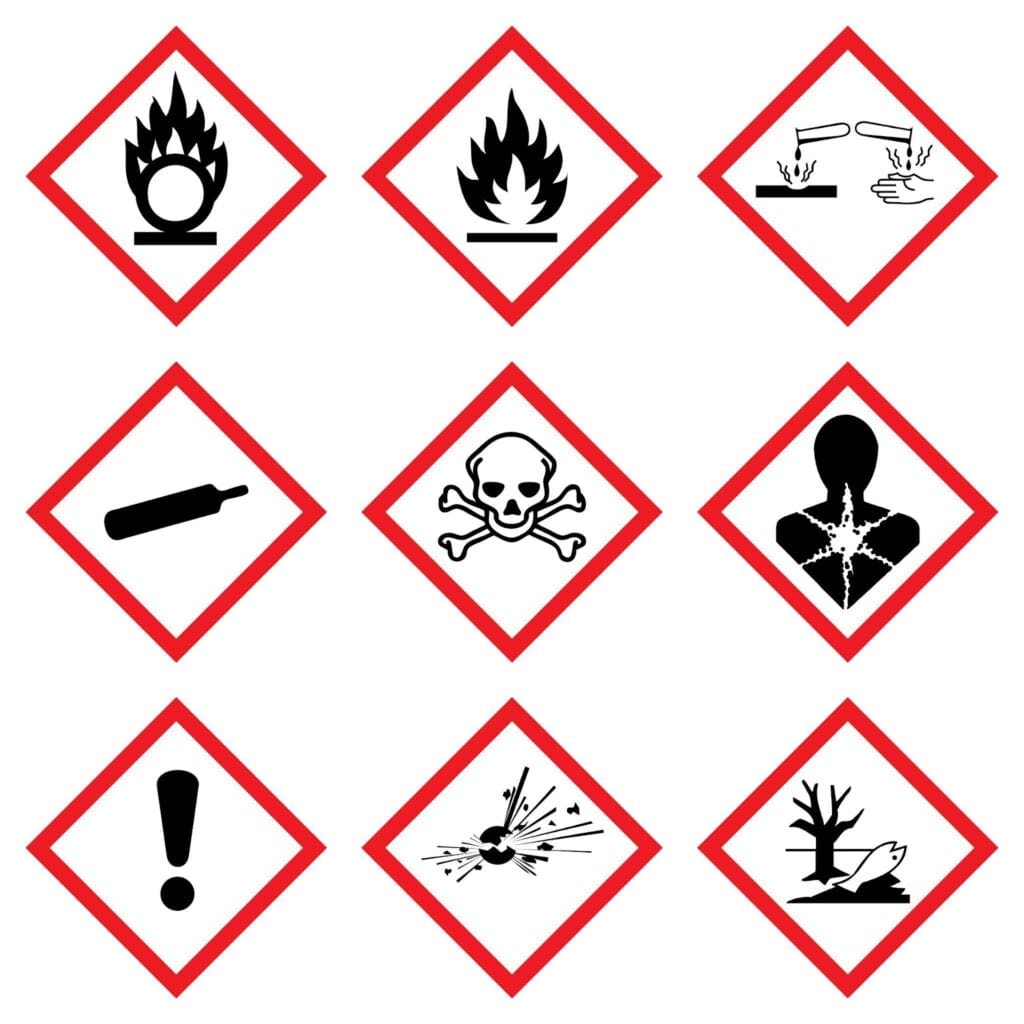
While you may be diligent with your risk assessment and risk controls while using chemicals, there are also risks associated with the storage of chemicals between uses.
While the risks and requirements for mitigation can vary between jurisdictions, it is important to ensure your chemicals are appropriately labelled, stored below maximum quantities, and any incompatibilities noted. Read on to learn more about the safer storage of chemicals.
Not all chemical families carry the same risks, so we categorise them into hazardous substances and Dangerous Goods (DG).

Hazardous substances are classified based only on health effects (whether immediate or long-term), while Dangerous Goods are classified according to the immediate physical or chemical effects.
Hazardous substances have the potential to harm human health, and there are many industrial, laboratory, and agricultural chemicals which are classified as hazardous.
Exposure to hazardous substances can result in, for example:
Dangerous Goods on the other hand are substances that are corrosive, flammable, combustible, explosive, oxidising, or water-reactive, or have other hazardous properties that can cause explosions or fires, serious injury, death, or large-scale property damage.
Storing hazardous substances safely is an important part of protecting you and your workers. This includes storing only what you need, ensuring that incompatible substances are not stored together, and that decanted substances are stored in the right type of container and correctly labelled.
The substance safety data sheet (SDS) is the first place you should look for information on how to store the substance and which other substances and materials it should be kept away from. Such information includes the Dangerous Goods classification, subsidiary risks, and packing groups.
Check for compatibility and segregation advice according to DG classes, as goods with different UN numbers within the same class might be incompatible. Where goods are incompatible, consider greater separation if the packing group is PG I or II, irrespective of the symbol used to account for the higher level of danger.
There are some chemicals that many industries use that really shouldn’t be stored together.
Always research materials you work with in order to work safely at your workplace—and segregate all incompatible chemicals for proper storage of chemicals by hazard class. In general, store like chemicals together and keep away from other groups of chemicals that might cause reactions if mixed.
The Chemwatch Incompatibility Reports feature in GoldFFX and Chemeritus will assist you in finding out the specific segregation requirements for your storage conditions. For more information, see our Webinar on this same topic.
Signs in and around your workplace need to provide clear, concise information about any hazardous substances. You will see GHS symbols on storage container labels and Dangerous Goods symbols on containers for transport, in addition to general warning signs around a premises.
Signs are required when you have hazardous substances exceeding specified quantities. Most jurisdictions have their own limits but in Australia, the Work Health and Safety Act (WHS) lays out the requirements, including the thresholds for placarding.

Signs should be placed at key points on your site, such as entranceways, on buildings, or in outdoor areas where hazardous substances are used or stored in bulk. They should be clearly visible and not obscured in any way.
As a general rule it is required that placards are durable and readily visible. The information must be legible from not less than 10 metres away under varying conditions, such as poor lighting and rain.
A hazardous chemical register is a list of all hazardous chemicals stored, handled, or used at a workplace. Chemical SDS must be included with the register and must be readily accessible to all workers involved in the use, storage, and handling of the hazardous chemicals at the workplace, as well as available to emergency service workers.
Manufacturers and importers of hazardous chemicals are required to update their SDS at least every five years. If the recorded SDS in a workplace has not been updated for five years or more, businesses should contact the chemical supplier, manufacturer, or importer for the current version.

A manifest, in contrast to a register, is a written summary of hazardous chemicals with physical and acute toxicity hazards that are used, handled, or stored at a workplace. A manifest is only required where the quantities of those hazardous chemicals exceed the threshold amounts listed in Schedule 11 of the Australian WHS Regulations.
The primary purpose of a manifest is to provide emergency services with information on the quantity, classification, and location of hazardous chemicals at the workplace. It also contains information such as site plans and emergency contact details. Manifests must be updated as soon as practicable after any change to the amount or types of chemicals being used, stored, handled, or generated at the workplace.
Chemwatch provides chemical register management tools to ensure regulatory compliance in your jurisdiction, using regulatory lists from over 90 countries.
If you want to know more about chemical safety, storage, or regulations, we are here to help. At Chemwatch we have a range of experts spanning all chemical management fields, from heat mapping to Risk Assessment to chemical storage, eLearning and more. Contact us today to find out more at sa***@*******ch.net.
Sources: